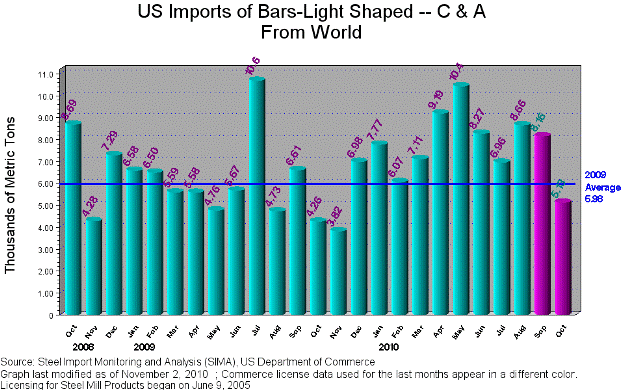After decreasing in October, US merchant bar asking prices are expected to level out this month despite the increase in shredded scrap pricing.
While scrap pricing overall has experienced a slight rollercoaster of sorts in the last few months, the trend for domestic merchant bar has tilted undeniably down. In mid-October, mills cut transaction prices by $1.50 cwt. ($33/mt or $30/nt), despite keeping prices for other long products (rebar, wide flange beams) level. Even with the lower prices, drastic discounting was still rampant in the market, with some deals reported as much as $3.00 cwt. ($66/mt or $60/nt) below official prices.
In response to the shredded scrap increase of $20/long ton this week, mills will likely, on the surface, appear to neutralize prices by matching the raw material surcharge increase with a base price decrease. However, it is widely speculated that regardless of mills' official positions on merchant bar prices, deep discounts will prevail. For now, pre-mill-announcement prices for merchant bar are in the range of $37.80-$43.00 cwt. ($833-$948/mt or $756-$860/nt) ex-mill, depending on size and shape, and there is further speculation that once mills make an announcement, it will be for January 2011 pricing instead of December 2010. While this tactic is not typical, it has already been utilized in announcements for special bar quality (SBQ) products; Nucor announced a base price increase on Wednesday that isn't effective until January 1, 2011.
As spot prices for merchant bar continue to slide, demand, at least, seems to be marginally improving. Distributors reported a small uptick in demand at the end of October, which has already carried over into this month. Surprisingly, construction is leading the way in this positive uptrend, with more projects moving from the planning stage to the production stage. Additionally, there is a strong feeling that businesses will be more comfortable with making construction decisions and banks will be more open to lending following the results of Tuesday's election.
In September, however, the weak demand that was instrumental in mills' decision to drop October prices is evident in service center shipment and inventory data. According to the latest MSCI Metals Activity Report, monthly shipments dipped in September while month-ending inventory levels rose slightly. Monthly shipments of merchant bar totaled 287,100 nt in September, compared to 292,900 nt the month prior. Inventory levels, on the other hand, were at 736,600 nt in August, and rose up to 737,900 nt the next month.
MSCI data for October will likely show a further increase in monthly shipments and drop in month-ending inventories for US service centers, partially because the import market for merchant bar is so tepid. Prices have dropped from certain sources, but overall, demand levels have not improved to the point where US buyers are taking a serious look abroad. Currently, offers from Turkey have decreased by about $0.50 cwt. ($11/mt or $10/nt) in the last month, bringing prices into the range of $37.00-$38.00 cwt. ($816-$838/mt or $740-$760/nt) FOB load truck at US Gulf ports for small sections and some structural channels and angles according to ASTM A36/A6. Mexican offers have also dropped by $0.50 cwt. with prices now in the range of $35.50-$36.50 cwt. ($783-$805/mt or $710-$730/nt) duty paid FOB delivered to the US border. While import offers are slightly under official domestic ranges, the aforementioned deep discounts have severely undercut the competitiveness of imports.
Current import shipments, however, also seem to be experiencing a downward trend. According to license data from the US Import Monitoring and Analysis System (SIMA), the US only imported 5,130 mt of merchant bar in October, compared to 8,087 mt (preliminary census data) in September. While October levels are the lowest since November 2009, the drop is almost entirely attributed to a drop in Canadian levels. The US imported 2,412 mt of merchant bar from Canada in October, compared to 4,790 mt the month before. However, import levels from the US' other main sources of merchant bar, Mexico and Turkey, stayed relatively level (each saw a slight drop, but nothing like the halved levels from Canada). Because limited import activity has been reported by US distributors for months, November import levels are expected to reflect a continued downward trend.
